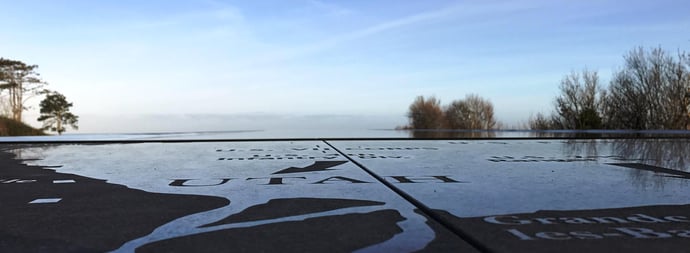
The Marshall plan, which was presented to the Cotentin Peninsula in 1947, brought some relief to the people there.
Here is the previously untold story of Dday to the fall of Cherbourg (6 – 27 June 1944), recounted by local civilians.
June 1944! In the last few weeks, bombing and strafing had intensified throughout France: communication nodes, railways, and major industrial centers were frequently visited by allied aviation, which was rising, stronger each time, against the onslaught of German power.
In the last few days, the Norman region and the north of France were subject to increasingly frequent raids, their violence escalating as time passed; we had the impression that this time it was the famous "Atlantic wall" (and why not the Manche department too?) that was more specifically targeted, and decisive and painful hours were yet to come.
At the beginning of June, no one doubted the impending attack on "Fortress Europe."
On the 5th, the newspapers spoke only of the last bombardment of Rouen, of the "martyrdom of the City-Museum." They also informed the population of the destruction brought to the four corners of the country: from Marseilles to Paris, through Avignon, Bourges, Epinal, Versailles, Mantes, etc.
What was once called the Lower Normandy was not spared either: the “Manche," which had already paid a heavy price to the war, continued to face devastation, in the form of dead citizens and a ruined landscape. The bastion that was the fortress of Cherbourg had lived four days and four tragic nights: peaceful villages where the Germans had fortified themselves and stood on the defensive were wiped forever from the map.
Note: Until recently, Lower Normandy was composed of three components: Orne, Calvados and Manche
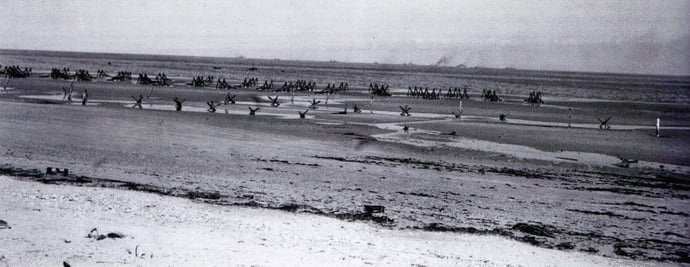
View of the Atlantic Wall from the Widerstandsnest 14
And in the night of the 5th to the 6th of June, it was the landing, the famous landing announced so long that many had ceased to believe it, dared not hope for it, this landing about which the “Boche” laughed, hidden in his molehills of concrete—he who believed himself so well sheltered behind his "wall."
Note: Boche is an offensive term used for German descent, still well anchored in the minds of the elderly with whom I talk!
Throughout the night Normandy resounded with the noise of bombs and cannon; through the duration of the attack, the sky was streaked with lightning and furrowed by innumerable planes, whose regular purring was dominated by the thunder that accompanied a deluge of iron and fire. A hundred miles from the coast no one could sleep.
On the morning of the 6th, the news spread like wildfire; the details were scarce, but everyone knew that a multitude of gliders had landed in the Normandy countryside, under the protection of thousands of planes; a fleet of rare power had accompanied innumerable landing ships, and important allied forces had gained a foothold and continued to pour out with considerable equipment on the coasts of Calvados and the Manche, particularly between the mouth of the Orne river (Sword beach) and the tip of Barfleur (above Utah beach).
Almost at once, everyone understood that the first objective of the Allies was Cherbourg.
The Americans immediately set themselves to isolating the northern part of the Cotentin Peninsula, that portion of the Manche demarcated to the south by the marshes and, more or less, by the Carentan - Carteret railway line.
With hope mixed with anxiety, every day, every hour, the Normans wondered: "Will they succeed?" This question was asked by all of France as well as the rest of the world. We also thought, alas, of the ruins already accumulated, the ones to come. Our beautiful province, a land of prosperity, toil, sacrifice and beauty, the ancient land of cathedrals and abbeys, was sacrificed, especially the departments of Calvados, and the Manche... what destruction would still bring us the formidable honor of having been the first to welcome the Liberators of oppressed France!
Towns and villages in Normandy had been mutilated during these four long years of occupation.
In the Manche whilst diversionary attacks were being launched on Barfleur and Saint-Vaast-la-Hougue and against the Channel Islands ... the bulk of the landing took place in the bay of the Veys, at the mouth of the Vire and under Sainte-Marie-du-Mont: Utah beach.

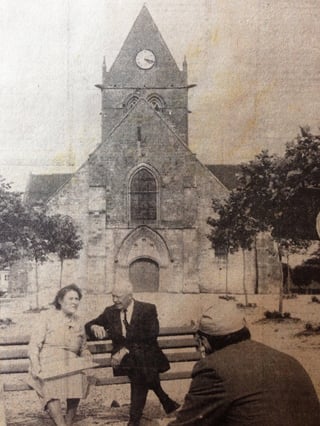
Sainte-Mère-Eglise, June 7, 1944 President Eisenhower welcomed by Mrs Renaud on the 9th of August 1963
In the region of Sainte-Mère-Eglise, parachutists of the 82nd Airborne Division fell in numbers as gliders crash landed in the fields filled with the infamous asparagus of Field Marshall Erwin Rommel.
Carentan thus became the center of the fighting from the first hour, and it is difficult even today to understand why the city had suffered so little damage. The 270 houses destroyed or deteriorated do not change the intrinsic physiognomy of the small town, which nevertheless counted in 1944 1016 victims for 3876 inhabitants, mourning 50 dead. It has preserved intact its arcades and its old church of the XV century, classified as a historical monument.
1st Anecdote: Carentan once had a famous castle, and Henry I, King of England, trampled upon its soil. “Jean sans Terre” signed charters there in 1199. Later, Edward III destroyed the "fort chastel" and razed the fortifications. In 1364, Du Guesclin took the stronghold ... Carentan was finally the seat of an Admiralty. Here was born in 1732 Jean Baptiste Elie de Beaumont, the famous defender of Jean Calas.
2nd anecdote: Jean Calas (1698 – March 10, 1762) was a merchant living in Toulouse, France, who was tried, tortured and executed for the murder of his son, despite his protestations of innocence. Due to Calas being a Protestant in an officially Roman Catholic society doubts were raised about his guilt and he was exonerated in 1764. In France, he became a symbolic victim of religious intolerance, along with François-Jean de la Barre and Pierre-Paul Sirven.
At all times the importance of Carentan was considerable; it was the only point in the department with the ford of the Grand Vey where it was possible to cross the line of the marshes towards the Bessin and the rest of the province. As early as the year 1350, one and a quarter mile to the north had been established a fortress, a bastion called Ponts d'Ouve, which was razed in 1599. This bastion commanded the mouth of La Douve, a small river of 22 miles toward the south, the "Clos du Cotentin", which, Jean Froissart wrote in his famous Chronicle, "is the richest country in the world."
Anecdote: Jean Froissart (c. 1337 – c. 1405) was a French-speaking medieval author and court historian from the Low Countries, who wrote several works, including Chronicles and Meliador, a long Arthurian romance, and a large body of poetry, both short lyrical forms, as well as longer narrative poems.
On this river, whose bed is surrounded by impassable marshes most part of the year, four other passages existed apart from the Ponts d'Ouve: those of “Pont-l'Abbé,” “Beuzeville-la-Bastion,” “La Sensurière,” and “Saint-Sauveur-de-Pierrepont.” This natural line of defense of the Cotentin was extended to Port-Bail. Each of the important passages had its bastion.
Nowadays, just as in the past, one cannot choose better than holding this line to prevent an enemy coming from Carentan to penetrate the peninsula of Cotentin. The same inconvenience existed for an enemy who landed in the north of the peninsula and wanted to get out! In this case, it was a question of preventing the Germans from bringing reinforcements from the area south of the marshes in order to reinforce the Cherbourg garrison.
Sainte-Marie-du-Mont suffered even less. Its church of noble elegance, classified as a historical monument, is nearly intact. This building dates partly from the 11th century. The bell, a small marvel in the flamboyant style of the XVI century, received only a few American shells which have seriously damaged it, but the bell has lost nothing of its grace and magnificence. The 502nd PIR of the 101st Airborne Division who took the Holdy battery kept one gun… and used it to shoot the tower bell of the church in Sainte-Marie-du-Mont!
From the first hours of the landing, the 82nd and 101st Airborne Divisions were engaged in violent combats, especially in the regions of Sainte-Mère-Eglise and Picauville; it was necessary to cut the Cherbourg-Paris road between Carentan and Valognes, and assailants were to become masters without delay of the Pont l'Abbé, which presented the same strategic importance as the Ponts d'Ouve.
The Pont l'Abbé, which gave its name to Picauville's main agglomeration, commanded the center of the Douve valley. It was the object of a fierce battle; many paratroopers were tragically killed in the trees (where they remained hanging), others fell in the swamps and drowned there.
Note: Field Marshall Erwin Rommel, a history buff just like General George Smith Patton, discovered what Napoleon had done back in time to stop the potential invasion of the British: swamp the Cotentin Peninsula! Rommel ordered the soldiers to dig deep trenches, set-up anti-personnel waterproof mines, put in place the infamous “Asparagus”, dig in wooden spikes like the Romans and cover everything with water. Needless to say it wasn’t in the interest of the paratroopers to fall in the swamped area.
On the 6th of June, a brighter day, some paratroopers killed the German General Wilhelm Falley and the members of his staff, as they left the castle of Bernaville. The disappearance of the chiefs was fortunate, as it created disorganization & confusion within the enemy. On the other hand, the German Flak of the Pont l’Abbé shot down five transport planes and one of the Red Cross, whose occupants perished.
The bombardments succeeded one after another; many houses and part of the Bon-Sauveur were already destroyed when, on the 9th, the Americans entered Picauville. Taken and lost several times, Picauville and Pont l’Abbé were definitely liberated on the 13th of June. Of Pont l'Abbé, there were only ruins left. What the incendiary shells and bombs of the Americans could not destroy was destroyed by the German air force and the troops of Hitler, who set ablaze the village while retreating.
At the cost of great efforts and heavy losses, the allies succeeded in maintaining themselves on the territory, clinging to the Norman land and widening their bridgeheads. On the Channel Islands, in Barfleur, landing attempts failed, but these were only diversionary maneuvers. Between Carentan and Saint-Vaast-la-Hougue, a few kilometers from the sea, the batteries installed by the Germans kept firing: the Allied navy and aviation were trying to silence them, like the others.
But the Boche, on the evening of the first day, was to recognize the formidable power of the assailant. A breach had been made in the Atlantic Wall!
It was necessary at all costs to prevent the German reinforcements from coming to the rescue of the armies in difficulties in the Cotentin. This was done, and it was terrible! It cost Normandy dearly the first night after the invasion. The allied aviation focused on the towns, all placed at the intersection of important roads, Vire, on the threshold of the department. Valognes, Coutances, Périers, Lessay, and Saint-Lô lived long hours of terror, and disappeared, in whole or in part, in the clatter of bombs. In Lessay, at Coutances, clouds of parachutists were still falling and the communiqué announced violent street combats in Sainte-Mère-Eglise.
Sainte-Mère-Eglise is only ten kilometers or so from Utah beach! Nevertheless, it mourned the deaths of 30 people. 50 others were wounded during the fighting, and 342 inhabitants out of 1163 and 125 houses were also destroyed.
In the township of Sainte-Mère-Eglise, the villages of Amfreville, Beuzeville-la-Bastion, Gourbesville, Hiesville and Vierville were also affected. All of them accounted for 20 to 40% of houses destroyed.
For two days, the battle will continue in the same areas: around Bayeux in the Calvados (La Pointe du Hoc, Omaha & Gold beach), between Carentan and Valognes in the Manche (Utah beach). But the two main bridgeheads are constantly reinforced, and the one of Sainte-Mère-Eglise extends gradually to the north and south. Saint-Côme-du-Mont received shells: its church, partly of the Romanesque period, collapsed; fourteen houses there were destroyed. It’s still known today as Dead Man’s Corner.
The cannon roared endlessly, on land as on sea; the aviation was active. The bombs fell continuously for days and nights. It was a hell, both for the civilians and for the soldiers placed in the zone of fire. Villages were crushed— men, women, children died. Carentan was still in the hands of the Germans; Coutances crumbled under the shells of the Allied fleet...
The German communiqué of June 9 located the crucial bridgehead between Carentan and Valognes. The Allies received reinforcements; hundreds of gliders lay in the vast meadows on either side of the road, and villages were taken and lost. You will be surprised to read that Blosville is still there; by some kind of miracle, the damage was minimal... but the men fall. And on the edge of this road (Sainte-Marie du Mont to the south, Sainte-Mère-Eglise to the north), harshly disputed, the corpses lined up... endlessly.
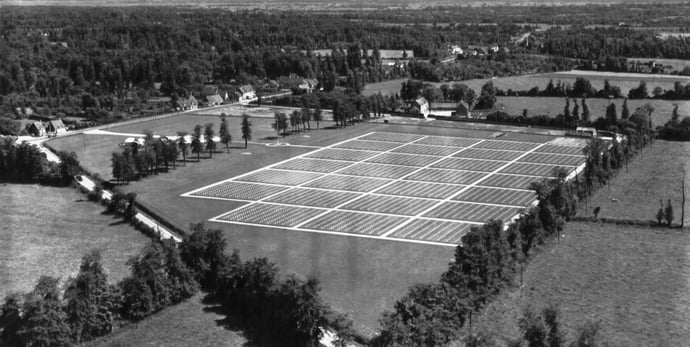
Blosville temporary American cemetery
Now, near the hamlet of Forges, in the Chef-du-Pont area, a few meters from this coveted road, white crosses are lined up as far as the eye can see. In this enormous temporary cemetery sleep forever thousands of American soldiers, KIA on the Normandy coast, for the reconquest of our freedom, for the defense of our rights.
Note: during the Normandy campaign and until 1948, 12 temporary cemeteries existed for the fallen until the ABMC (American Battle Monument Commission) received clear instruction of the family where the deceased should be resting. Today two WWII American cemeteries are in Normandy, the Normandy American Cemetery of Colleville-sur-Mer (Omaha beach) and the Brittany American Cemetery of Saint James (near the Mont Saint Michel).
The Germans, too, paid a heavy price. They now rest at Orglandes, in a vast necropolis, in the shadow of the mutilated bell tower, near the destroyed village ... so destroyed that the statistic established the day after the liberation bears: "Village and church burned; a family still lives in a pigsty!"
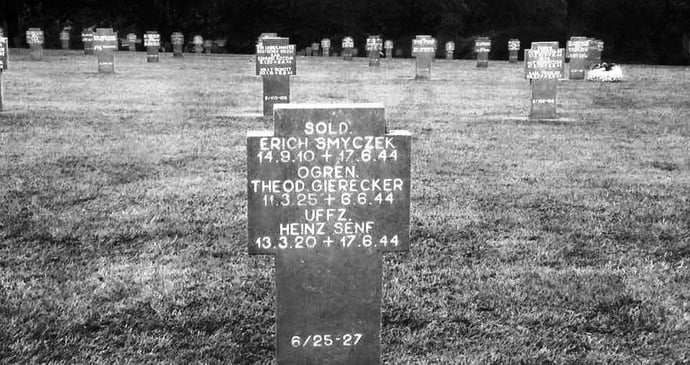
Orglandes German cemetery
The allies tried to break through to Saint-Lô and reach Valognes then Cherbourg, which they needed to land their heavy equipment. Towards Saint-Lo they were stopped; one has the impression that they did not carry their main effort on this side. They progressed slowly but surely towards Valognes. In this sector, the thrust was accentuated; the resistance hardened; the damages were important, considerable.
Note: due to severe weather conditions, the Mulberry harbor of Omaha beach is totally destroyed, thus the decision to hold back the troops near Saint-Lô until Cherbourg is captured and operational.
On June 11, the Americans managed to make the junction between Isigny-sur-Mer and the north of Carentan; they were now in control of this part of the Norman coast. The fighting moved to the north— it was now located in the Montebourg - Quinéville region.
In front of Montebourg, the Americans were stopped; the coquettish village was taken, retaken, lost and lost again. On June 12th, its streets would be the theater of fierce fighting. What was spared by bombs and shells would be burnt by the Germans; they mocked the panic-stricken, terrified civilians, throwing them out of their houses and, their work of destruction accomplished, openly rejoicing and applauding the magnitude of the blaze.
Anecdote: The Romans had occupied Montebourg, where there are still some vestiges of a camp called Mont-Castres. As early as the 11th century, Montebourg had a Benedictine abbey whose church had a mixture of Romanesque architecture. This building, founded in 1090, the largest and most remarkable of the peninsula of the Cotentin, was consecrated in 1152 in the presence of Henry II King of England and Duke of Normandy
Montebourg was one of the most affected communes in the department. It is no more than a skeleton: you can see nothing but burnt walls, blackened ruins. This coquettish city, known universally for its fairs and frequented by breeders from across the Atlantic, is no more than memory. 65 of her children were killed during the battle; of its 1542 inhabitants, 1342 are affected, the others partially; of 487 houses, only 12 are intact, 393 completely destroyed.
At the other end of the line of resistance, Quinéville also suffered. The Azeville German battery, which interfered with the junction of the allies, needed to be reduced to silence; the bombing brought the destruction of 75 houses, and 169 victims for 370 inhabitants. Nearby, Fontenay-sur-Mer and Saint-Marcouf were ravaged. Again, half the population was homeless: not a house that was untouched, 40 disappeared, including two castles! 36 people were killed. In the neighborhood, it was hardly better. 85% of the inhabitants of Ozeville were without a roof; Emondeville— only 25%!
In the southwest, the battle line followed the flow of the Merderet from Sainte-Mère-Eglise to La Douve.
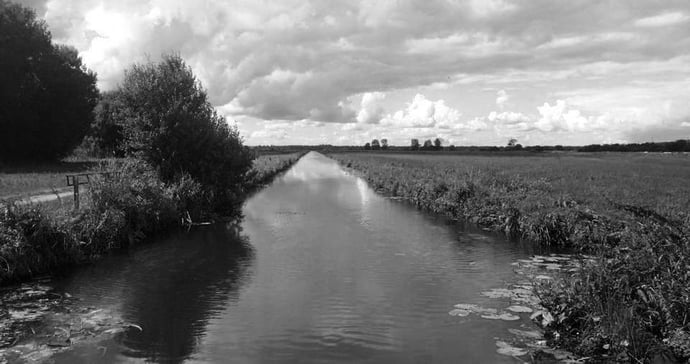
Swamps of the Cotentin Peninsula
The Merderet made the front of the headlines! It was a sad honor for this river, this stream to be more exact, whose celebrity, somewhat malodorous, had hitherto scarcely passed the limits of the Valognes region, which it watered with its lazy and regular flow. A stream that you could jump without the help of a pole! It is true that for two long months humble villages of the Cotentin Peninsula, unknown to the world, would be revealed on the radio during the fierce fighting that will take place there.
The Merderet flows into the Douve, whose waters pour into the bay of the Veys, after following an important line of marsh and waters Picauville, where, precisely, the Merderet joins the Douve.
On this line of the Douve, the German resistance was easy and pronounced: the enemy had flooded the vast meadows, where the depth of the water reached in places up to 2 meters. But by a bold and vigorous night attack, airborne troops succeeded in ensuring the passage of the Douve, while a little farther north the 9th Infantry Division, composed of the veterans of the campaigns of Tunisia and Sicily, took down the city of Néhou, after furious and bloody fighting.
Note: The “Ghost of Normandy” will achieve an extraordinary feat in Néhou at the risk of his own life above and beyond the call of duty… but that’s another story!
Meanwhile the British squadrons began to pound the northern and eastern points of the Cotentin; and with the support of the British navy, the Allies succeeded in taking Carentan on June 12th, the Germans "considered it better to lose than to engage their forces in inopportune times!" The "elastic defense"... Other elements were heading towards the west coast which they were to reach, on June 18th, in the region of Port-Bail, thus finally cutting off the peninsula.
Montebourg taken, the push continued in direction of Cherbourg, with Valognes for first objective. When the Americans entered the city, they found it 75% ravaged by the bombardments of the preceding days.
Anecdote: Montebourg was built near the remains of the Gallic-Roman city of Alauna, destroyed by fire in the III century, uncovered in 1695 by a local priest! Its name appears in modern history in 1027. It was the favorite residence of William the Conqueror, who signed numerous charters during the visits he made there, especially between 1053 and 1066. Later, the city was attached to the King’s Domain; “Jean sans Terre” and Saint Louis stayed there. In 1346, Edward III, King of England, who had just landed at La Hougue, resided at Valognes, where in 1355 was signed the treaty known as "Traité de Valognes", by which John the Good yielded to Charles the Bad the whole of the Cotentin peninsula. Wonder why! Soon the war resumed and “Du Guesclin” besieged and took the city in 1364 ... The castle was razed in 1689.
This beautiful aristocratic city lost most of its rich artistic heritage, and thus her name: the "Versailles of Normandy." After the bombardment nothing remaineed, and the greater part of Valognes became a virtual desert; the stones themselves are no longer seen. Mullions, gargoyles, and chapiters have served to fill the enormous craters left by the bombs.
Beautiful hotels with noble lines, those old aristocratic mansions surrounded by magnificent parks, rich in memories of the past, are all gone. An example amongst many others was the “hôtel de l’amiral de Bourbon,” spouse of Jeanne, natural daughter of Louix XI or the “Hôtel de Sainte-Suzanne,” where "Louis Stanislas-Xavier, King of France" was lodged under the name of Louis XVIII.
The hotels of the nobles "too vast and too beautiful" sheltered the crowd of the homeless. More than 4,000 “Valognais” lived in 300 small houses. The city lost 988 buildings and 3946 of its 4989 inhabitants were affected. More than 300 dead!
On June 16th, Saint-Sauveur-le-Vicomte was occupied by the Allies, after the Germans had burnt the corpses of their soldiers there. Half the city was destroyed. In the aftermath of the battle, the sculpture of the famous novelist Barbey d'Aurevilly executed by Rodin, who influenced, among others, the famous American writer Henry James and French writer Marcel Proust, remained alone in the midst of the ruins! Barbey's haughty gaze seemed to have stopped forever, frozen, over the distressing spectacle; a city which he had loved, as a loved one, was no more! 1320 of the 2124 inhabitants of Saint-Sauveur-le-Vicomte were disaster-stricken, 14 were killed. Thus, in a few hours, centuries of history disappeared.
Anecdote: the origin of the village dates back to Roger, the oldest viscount known, who died around 996, founder of the Benedictine abbey. The imposing castle of the XIV century was severely bruised; it had been besieged and taken in 1375 by Admiral “Jean de Vienne”. The parish church (partially dating back to the XIII century) suffered from the fighting, but retains intact its beautiful woodwork of the XVI century and its reputed “Ecce Homo” of the XV century.
Note: Ecce homo is a painting of Christ wearing the crown of thorns
The superb abbey, rebuilt a century ago by Sainte-Marie-Madeleine Postel, went back to ruin. Only the charred walls remain standing!
Anecdote: Marie-Madeleine Postel, born Julie Françoise-Catherine Postel (28 November 1756 in Barfleur - 16 July 1846 in Saint-Sauveur-le-Vicomte, France) was a Roman Catholic saint who founded the Sisters of Christian Schools of Mercy in 1807. She was beatified in 1908 and canonized on 24 May 1925.
In the meantime, the 9th Infantry Division reached Bricquebec and Les Pieux, which were freed without any damage.
From Valognes to Cherbourg, along the main road and in the surrounding countryside, ruins after ruins: not a house, not a farm, not a village that had not suffered damage, often irreparable.
The fortress of Cherbourg set up its first defenses halfway between Valognes and the great port of the Manche department: anti-tank ditches, cannons, armored casemates, and blockhouses with mobile turrets surrounded the entrenched camp. To liberate Cherbourg, it was these multiple defenses that had to be reduced, one by one, at the cost of heavy sacrifices.
After battles of rare violence, on the 20th day of the invasion Cherbourg fell! The German communiqué of the day before spoke of swarms of planes, bloody fighting in the ruins of the city, fierce struggles for each district, for each block of houses.
Here is what actually happened before the Americans entered the famous fortress!
After forcing the exterior defenses, the Allies reached the immediate outskirts of the city, from the east, south, and west, and occupied the heights of Tourlaville, Octeville, and Nouainville; yet they could not take down the Fort de la Roule, key resistance of Cherbourg. From June 22nd to June 25th, artillery bombardment and diving planes on the forts gave no results. The Americans tried to make their way to the casemates dug in the rock, to the north, under the mountain of the Roule and to the blockhouses erected on the plateau; their efforts were in vain. The German guns on rails continued to fire from the city on the top of the plateau!
To put an end, the American aviation made a massive raid of extreme violence on the Roule: the whole district was ravaged, a cloud of smoke and dust blurred the horizon. When the mountain was again visible, it was no longer green, but white ... the rock is totally bare! More than 1000 pieces of artillery participated in this ultimate attack!
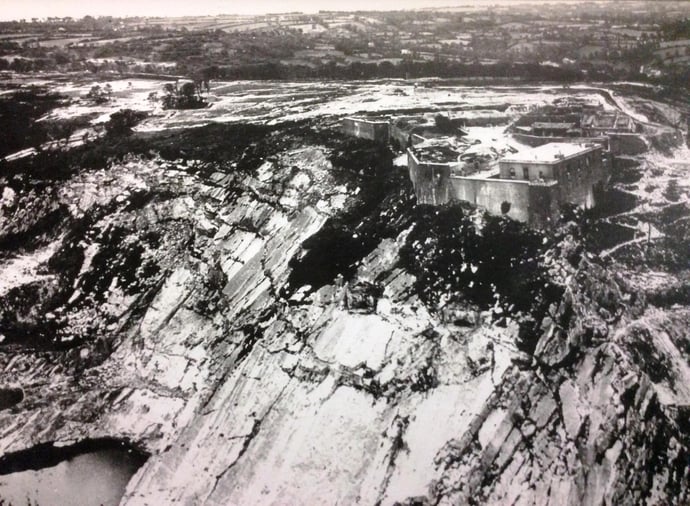
Fort of the Roule
The Fort of the Roule taken, the assailants dominated the city. On the 24th and 25th, they penetrated into the faubourgs; on the 26th, they progressed into the city, fighting street by street. It lasted all day, and involved some elements of the population. On the 27th, they finally occupied the center of the city.
It would have seemed logical to think that the “Gate of France” was sacrificed, that only ruins remained of Cherbourg. By a true paradox, Cherbourg is, with Bayeux and Granville, the only city of Normandy, to remain almost intact. Cherbourg had suffered greatly from regular bombardments during the four years of occupation, but her general architecture stayed unchanged.
Only the district of Le Roule, at the entrance of the town, was nearly razed; at the other end, the passenger terminal where the Titanic stopped over—one of the most beautiful in the world and the arsenal of the Navy no longer exist. Before their unconditional surrender, the Germ


















